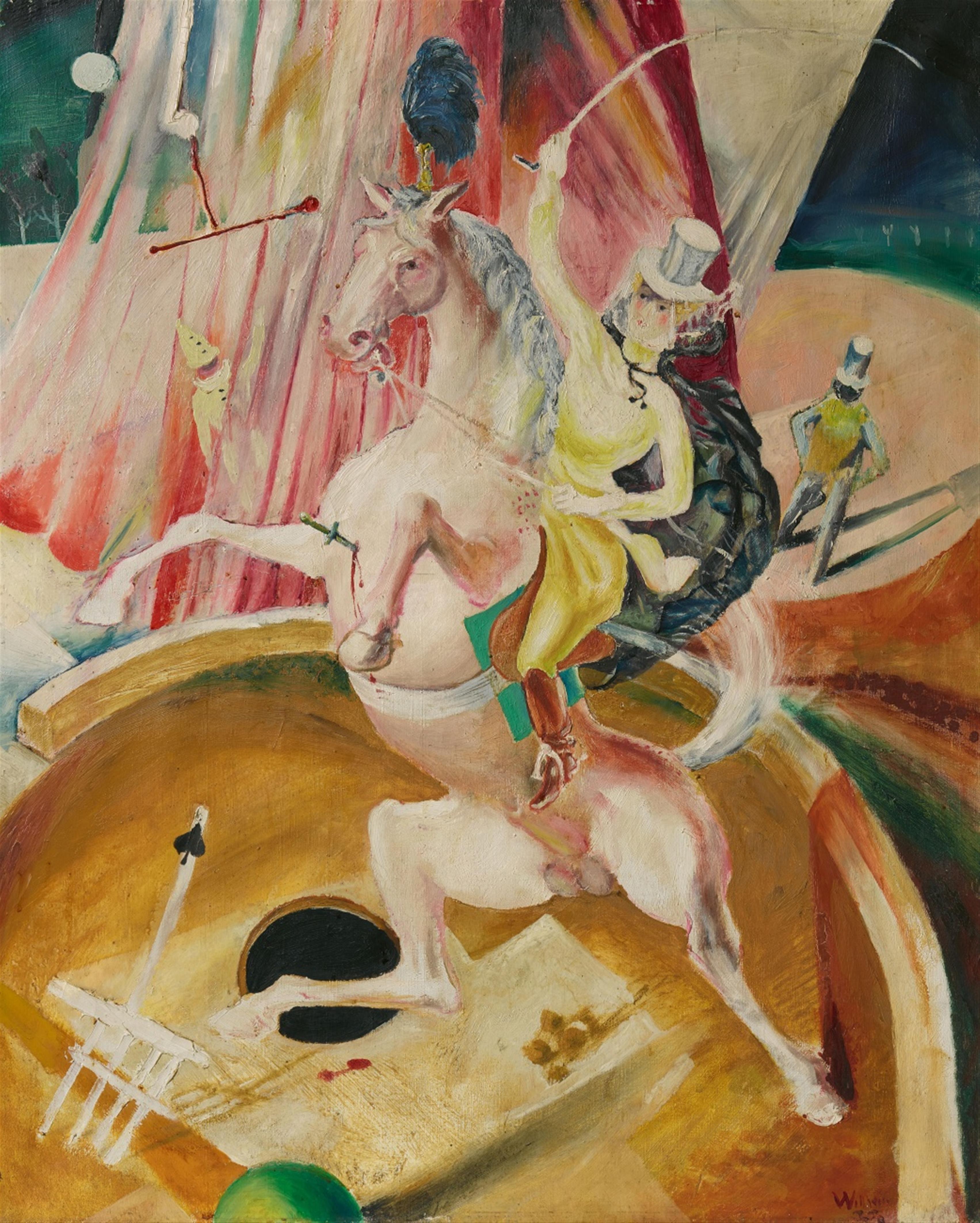Gert Heinrich Wollheim
Die Zirkusreiterin
1923
Oil on canvas 103 x 83 cm Framed. Signed and dated 'Wollheim 23' in dark red lower right. - In fine condition. Partially with minimal craquelure.
“Usually a picture tells its story; if you follow the path of the scene …, then soon there develops an intentional, ironic ambiguity, within which the readable message shifts.” (Ulrich Krempel, Miene, Geste, Pose, in: exhib. cat., Düsseldorf 1993, op. cit., p. 44).
Where the message is shifting to is also unclear in the painting “Zirkusreiterin”. Can the rider on the rearing stallion hold on? Is this part of the performance or is the horse going to bolt and bury us - also standing within the tiny circle of the circus ring, whether as circus director, painter or viewer - beneath him? Oscillating between danger, helplessness and admiration, viewers are left to their own uncertainty. Hiding in the spectral curtain of the spotlights there are clown-like, faceless, secondary figures who make the scene even more enigmatic: the one to the right may even be a reference to the “Gold Ball” from Oskar Schlemmer's “Triadic Ballet”, which was performed in Weimar that same year.
There are breakneck perspectives, extreme views from below and above. Having only just caught sight of the hole in the floor of the circus ring, into which horse and rider threaten to plunge, we also discover the dagger in the chest of the mighty animal and understand the dung, which at first seemed like a prank, as a reaction to fear and pain. Immersed in charmingly harmless shades of pink and red, this is a moment of extreme danger and dubious amusement - in which the princess mounted on the horse and gracefully waving her riding crop will maintain the upper hand, we hope.
Provocation and political activism provide a common thread in Gert Wollheim's work. As a member of the artists' group “Junges Rheinland” and a friend of the gallerist Johanna (Mother) Ey, he campaigned for a cartel of Secessionist artists' groups in order to strengthen their position against state and civic institutions. He stirred up Düsseldorf's bourgeoisie and opposed the academic organisation. He won two trials for slander and the accusation that his pictures contained indecent content. Wollheim was a friend of the lawyer Dr Friedrich Maase, who was interested in culture and art and would later become the founder of the Heinrich-Heine-Gesellschaft. The artist painted his portrait and that of his wife. These paintings, like others owned by Maase, were destroyed in the course of the Second World War or are considered to be lost: the “Zirkusreiterin”, which was also owned by this lawyer who suffered political persecution and imprisonment under the Third Reich, has remained preserved as a particularly impressive work by Wollheim from the early 1920s.
On the occasion of an exhibition of the “Junges Rheinland” in 1923, the year the “Zirkusreiterin” was created, Gerhard Schreiner wrote in the Social-Democratic “Volkszeitung”: “Gert Wollheim is an entirely different artist […]. He is the mystic of reason, the great prestidigitator […]. He paints down the things of the subconscious, the dream and the dynamic of the animalistic, the word and concept. His art is metaphysical speculation - condensed, for the moment, on the level of reality.” (Von Wiese, op. cit., pp. 216 f.).
Catalogue Raisonné
Euler-Schmidt 46
Provenance
Acquired directly from the artist by the previous owner, Dr. Friedrich Maase, Düsseldorf; in family possession, Baden-Württemberg, since
Exhibitions
Düsseldorf 1961 (Kunstmuseum), Gert H. Wollheim, cat. no. 6 with illus.; Berlin 1971 (Galerieräume Jebenstraße), Gert H. Wollheim. Malerei Graphik Plastik, cat. no. 44; Düsseldorf 1993 (Kunstmuseum Düsseldorf im Ehrenhof), Gert H. Wollheim 1894-1974. Eine Retrospektive, cat. no. 11 with full-page colour illus. p. 109

